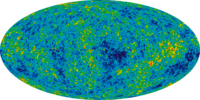
Photo from wikipedia
We conduct an analysis of the Planck 2015 data that is complete in reionization observables from the large angle polarization $E$-mode spectrum in the redshift range $6lzl30$. Based on 5… Click to show full abstract
We conduct an analysis of the Planck 2015 data that is complete in reionization observables from the large angle polarization $E$-mode spectrum in the redshift range $6lzl30$. Based on 5 principal components, all of which are constrained by the data, this single analysis can be used to infer constraints on any model for reionization in the same range; we develop an effective likelihood approach for applying these constraints to models. By allowing for an arbitrary ionization history, this technique tests the robustness of inferences on the total optical depth from the usual steplike transition assumption, which is important for the interpretation of many other cosmological parameters such as the dark energy and neutrino mass. The Planck 2015 data not only allow a high redshift $zg15$ component to the optical depth but prefer it at the $2\ensuremath{\sigma}$ level. This preference is associated with excess power in the multipole range $10\ensuremath{\lesssim}\ensuremath{\ell}\ensuremath{\lesssim}20$ and may indicate high redshift ionization sources or unaccounted for systematics and foregrounds in the 2015 data.
Journal Title: Physical Review D
Year Published: 2017
Link to full text (if available)
Share on Social Media: Sign Up to like & get
recommendations!